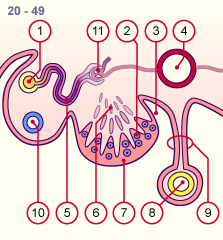|

|
|
|
3.2 Determining the gender
|
|
|
|
The key to sexual differentiation lies on the Y chromosome in the SRY (sex determining region of the Y chromosome). There the testis-determining factor (TDF) is found that induces male development. Among other substances, testosterone is formed beginning with the 7th week.
If no Y chromosome - and thus no SRY - is present, a feminine phenotype is engendered.
|
|
|
|
Under the influence of the TDF the primary germinal cords (gonadal cords) proliferate, grow into the depths, lose their attachment to the surface epithelium, and become testicular cords.
| Up to puberty the seminal cords remain compact; only then do they become a lumen and the primordial sperm cells develop into spermatogonia. |
|
|
|
|
|
Commentary
|
|
The spermatogonia are the primordial sperm cells from which, after several mitotic and a meiotic division steps, the spermatozoa are finally generated.
|
|
|
Fig. 6 - Gonadal ridge becoming
a testis; 7th week |
|
Fig. 7 - Gonadal ridge becoming
an ovary; 8th week |
|
Legend |

1
2
3
4
5
6
7
8
9
10
11 |
Mesonephric duct (Wolff)
PGC
Peritoneal cavity
Aorta
Mesonephric tubule
Gonadal cords
Coelomic epithelium
Intestine
Mesenterium
Anlage of the paramesonephric
duct (Müller)
Mesonephros-nephron |
|
|
|

1
2
3
4
5
6
7
8
9
10
11 |
Mesonephric duct (Wolff)
PGC
Peritoneal cavity
Aorta
Mesonephric tubule
Degenerated gonadal cords
Thickened coelomic epithelium
Intestine
Mesenterium
Anlage of the paramesonephric
duct (Müller)
Atrophy of the mesonephros-
nephron |
|
|
|
Fig. 6
Development in a male:
the testicular cords insert deeply into the gonadal primordium and lose contact with the surface epithelium.
Fig. 7
Development in a female:
the germinal cords degenerate in the medulla region. Through increasing proliferation of the coelomic epithelium, the germinal cords that have not lost contact with coelomic epithelium remain.
|
Female gonadal primordium
|
|
|
|
The primary gonadal cords in the medullary region degenerate since no SRY-gene exists in the female body. In the cortex region, on the other hand, the proliferation of the coelomic epithelium remains preserved - its cells surround the multiplying germinal cells. These remain near the surface, however and, in contrast to the germinal cords, are called cortical cords.
In the 4th month the cortical cords decay into isolated collections of cells and the epithelial cells surround one to two primordial germ cells, forming follicles. The primordial germ cells inside differentiate into oogonia and, with the first meiotic division, become primary oocytes. The interaction that then commences between primary oocytes with the surrounding epithelial cells stops the completion of the first meiotic division, which is then arrested until puberty begins.
| In the female organism the primordial germ cells already differentiate during the fetal period to become oogonia. |
|
Summary
The gender of an embryo is determined at the moment of fertilization and depends on whether the spermatozoon carries an X or a Y chromosome. In XX embryos the germinal cords do not grow as far as the medulla and the cortical cords envelop the oogonia. In XY embryos, on the other hand, the medullary cords become the testicular cords that also grow into the depths and establish contact with the mesonephros. . |
|
|
|
|